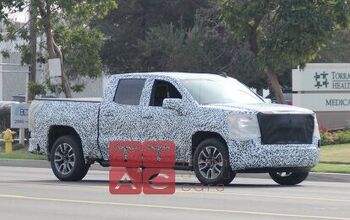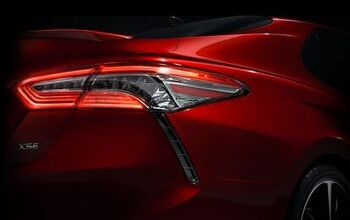Is Detroit Headed For Oversupply?
Third quarter North American auto production is headed for the 11.8m mark, even as analysts at IHS Automotive revise their sales projections downwards to 11.5m, once again raising the specter of oversupply which haunted Detroit for much of the last decade. GM, which is forgoing a Summer plant shutdown this year, is expected to increase its Q3 production by 32 percent over last year, as its market estimate ranges from 11.5 to 12m units according to Automotive News [sub]. Though that’s on the high end compared to the IHS number, and though GM’s market share has been anything but stable, the firm is keeping a steady hand on the tiller to maintain a sense of normalcy headed into its forthcoming IPO. And with inventories in far better shape than they’ve been in years, automakers reckon they can always get rid of extra cars when the market rebounds next year. In the meantime, however, the risks of overproduction are very real.
Chrysler, for example, has the highest inventory level in the industry at 60 days of supply. That’s considered the industry “ideal” for supply, but the fact that Chrysler’s competition is keeping supply even lower is a sign that a rapid sales recovery isn’t in the cards. Meanwhile, IHS’s Mike Jackson points out that Chrysler is only maintaining that volume through fleet sales.
Chrysler is relying pretty heavily on fleet sales. You have to play the cards you are dealt. They have to make sure they maintain volume
At the price of even greater resale weakness, brand degradation, and the perpetuation of Chrysler’s rental-car image. In short, Chrysler is already stuffing sales into fleets to (barely) meet its 95k monthly “survival” volume, keeping the lights on at the expense of future brand equity. With a wave of facelifts and refreshed product hitting the market soon, Chrysler can ill afford to keep up its fleet sales binge, let alone actually increase production volumes.
GM’s production increase is likely due at least in part to a ramp-up to Cruze production, while Ford’s 22 percent production bump is tied closely to the release of the new Fiesta. If both of those products make big initial plashes, the production increases associated with them could be worth the risk. Chrysler, on the other hand, is still months away from releasing new product, and there’s not much to indicate that a sales increase of its existing product is in the offing.
Meanwhile, with IHS revising its sales estimate from 11.8m to 11.5m, and talk of a double-dip recession bubbling away, it’s not impossible to imagine US-market sales falling lower still. If that happens, look for fourth quarter production to more than make up for the summer glut, and expect end-of-year sales to cut into razor-thin profit margins. After all, even Hyundai, which has several brand-new and red-hot products on the market is keeping its inventory down to a 35 day supply, or nearly half of Chrysler’s level. After all, the way for a brand to make a comeback is to build great cars and sell every one they build at full price. Chrysler already tried the volume-über-alles approach under Cerberus, and we all know how that turned out.
More by Edward Niedermeyer
Latest Car Reviews
Read moreLatest Product Reviews
Read moreRecent Comments
- Kwik_Shift_Pro4X Thankfully I don't have to deal with GDI issues in my Frontier. These cleaners should do well for me if I win.
- Theflyersfan Serious answer time...Honda used to stand for excellence in auto engineering. Their first main claim to fame was the CVCC (we don't need a catalytic converter!) engine and it sent from there. Their suspensions, their VTEC engines, slick manual transmissions, even a stowing minivan seat, all theirs. But I think they've been coasting a bit lately. Yes, the Civic Type-R has a powerful small engine, but the Honda of old would have found a way to get more revs out of it and make it feel like an i-VTEC engine of old instead of any old turbo engine that can be found in a multitude of performance small cars. Their 1.5L turbo-4...well...have they ever figured out the oil dilution problems? Very un-Honda-like. Paint issues that still linger. Cheaper feeling interior trim. All things that fly in the face of what Honda once was. The only thing that they seem to have kept have been the sales staff that treat you with utter contempt for daring to walk into their inner sanctum and wanting a deal on something that isn't a bare-bones CR-V. So Honda, beat the rest of your Japanese and Korean rivals, and plug-in hybridize everything. If you want a relatively (in an engineering way) easy way to get ahead of the curve, raise the CAFE score, and have a major point to advertise, and be able to sell to those who can't plug in easily, sell them on something that will get, for example, 35% better mileage, plug in when you get a chance, and drives like a Honda. Bring back some of the engineering skills that Honda once stood for. And then start introducing a portfolio of EVs once people are more comfortable with the idea of plugging in. People seeing that they can easily use an EV for their daily errands with the gas engine never starting will eventually sell them on a future EV because that range anxiety will be lessened. The all EV leap is still a bridge too far, especially as recent sales numbers have shown. Baby steps. That's how you win people over.
- Theflyersfan If this saves (or delays) an expensive carbon brushing off of the valves down the road, I'll take a case. I understand that can be a very expensive bit of scheduled maintenance.
- Zipper69 A Mini should have 2 doors and 4 cylinders and tires the size of dinner plates.All else is puffery.
- Theflyersfan Just in time for the weekend!!! Usual suspects A: All EVs are evil golf carts, spewing nothing but virtue signaling about saving the earth, all the while hacking the limbs off of small kids in Africa, money losing pits of despair that no buyer would ever need and anyone that buys one is a raging moron with no brains and the automakers who make them want to go bankrupt.(Source: all of the comments on every EV article here posted over the years)Usual suspects B: All EVs are powered by unicorns and lollypops with no pollution, drive like dreams, all drivers don't mind stopping for hours on end, eating trays of fast food at every rest stop waiting for charges, save the world by using no gas and batteries are friendly to everyone, bugs included. Everyone should torch their ICE cars now and buy a Tesla or Bolt post haste.(Source: all of the comments on every EV article here posted over the years)Or those in the middle: Maybe one of these days, when the charging infrastructure is better, or there are more options that don't cost as much, one will be considered as part of a rational decision based on driving needs, purchasing costs environmental impact, total cost of ownership, and ease of charging.(Source: many on this site who don't jump on TTAC the split second an EV article appears and lives to trash everyone who is a fan of EVs.)


































Comments
Join the conversation
Chrysler does have brand new product that did just come out... sure its an mid size SUV, not a compact car, but it is new product. There is also a slew of Refresh and new products coming out this fall... unlike GM who really doesn't have much of a pipeline right now, and Ford which has the Fiesta and new Focus to carry on for a couple of years of hype. While Chrysler's new stuff that we think is coming out may be vaporware, they delivered what they said they were going to with the Grand Cherokee... so I think their may be a wait. Out of that list that surprises me (well other than GM, that many Cruze are going to be sold?) Honda's forecast is quite optimistic.... where are these sales going to come from? From what new products? Have they not looked at recent sales?
It doesn't really matter. GM no longer needs to worry about profits. As long as BarryO holds the purse strings, he can just pump more tax payer into his UAW pet project.